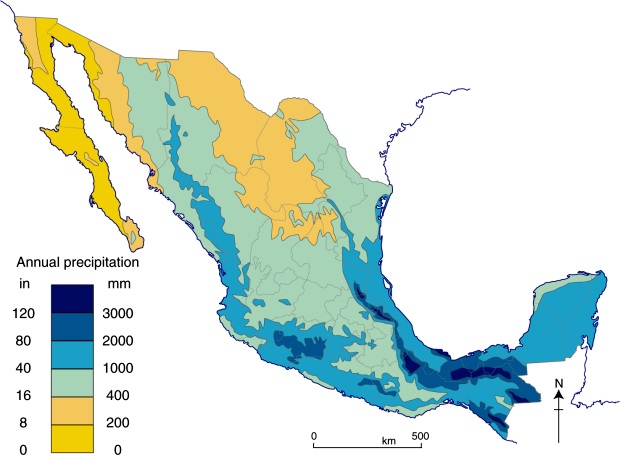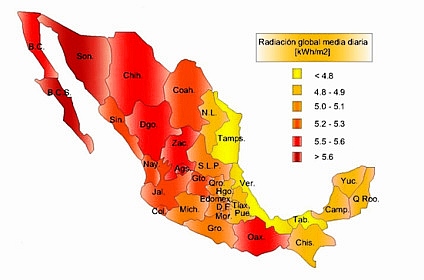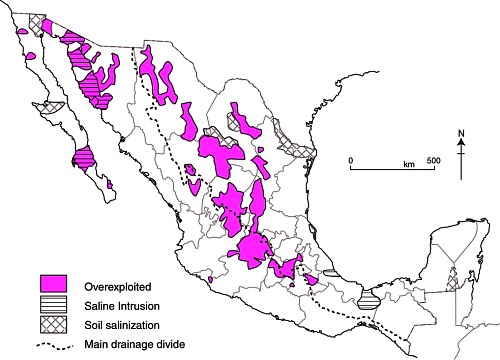This guest post, by C.G. Machlan of the fledgling Green City Development Organization, looks at the feasibility and practicality of establishing sustainable, accessible cities in Mexico.
If it is feasible and practical to build wind farms in Mexico then it must also be feasible and practical to build sustainable, accessible Green Cities. Here’s why!
Mexico has sufficient wind and solar resources as indicated by these two maps, of wind resource and solar radiation respectively:
Wind Farms
Mexico has approximately 31 wind farms occupying over 11,000 hectares in 8 states, generating more than 1,300 megawatts (MW) of power for the national grid system. Additional wind farms are in the planning and development stages. These wind farms are needed, and are an important component of efforts to increase Mexico’s electricity-generating capacity. Wind farms are ecologically clean, produce needed electricity for the national grid, reduce Mexico’s carbon footprint, and create some long term jobs.
Green Cities versus Wind Farms
While wind farms contribute to Mexico’s electricity-generating capacity they do little to help the long term employment situation in Mexico. On the other hand, Green Cities can help boost employment. The Green City Feasibility Study looked at 10 Mexican states and identified potential locations having sufficient wind, solar and moisture resources to support a Green City. When built, each city would be able to house an estimated population of 250,000 to 300,000, and could create more than 100,000 new jobs across all sectors. Each city would be totally sustainable as regards electricity, by incorporating vertical and horizontal wind turbines together with solar panels in both residential and non-residential areas.
The Green City Electrical Analysis suggests that a Green City will require 54.6 to 63.3 megawatts daily for an estimated 54,000 houses, and between 288 and 661 MW for the non-residential areas at the projected mean and maximum population levels. This is a similar number of megawatts to the 250 MW produced by the Eurus Wind farm located in Juchitan de Zaragoza, Oaxaca, or the 632 MW, oil fired, Puerto Libertad power plant in Pitiquito, Sonora, but has the very important additional advantage of helping to create more than 100,000 new jobs in each city.
Green City Water Sustainability
Both electricity and water are essential for any city, Green Cities included, to grow and prosper. If Green Cities are located in areas where there is good wind speed/density and sufficient solar radiation to produce the electrical energy required, then the next question becomes, “Is there enough water available?”

Annual precipitation in Mexico (Fig .4.3 of Geo-Mexico, the geography and dynamics of modern Mexico) All rights reserved.
The normal rainfall season in many areas of Mexico is from May through September, so Green Cities would need to rely on aquifers as a year-round water source. Mexico has 653 identified aquifers, more than 100 of which are said to be overexploited.
Fortunately, Green Cities can be totally water sustainable by:
- Recycling all wastewater to a quality suitable for potable use.
- Incorporating “Air to Water” methods to obtain replacement water thus reducing aquifer usage.
- Designing runoff systems to collect and clean rainfall (stormwater) when it is available.
- Recharging aquifers, using excess water obtained from stormwater runoff.
The Green City Water Analysis estimates that a typical Green City will consume 71,563 cubic meters of water daily. Of this amount, 48,904 cubic meters will become wastewater requiring treatment. Assuming that 10% of the wastewater is lost during processing, approximately 24,925 cubic meters of replacement water will be needed daily, which must come from an aquifer, rainwater and/or “Air to Water” methods.
Calculations indicate each city could be fully water sustainable if rainwater was efficiently harvested. Assuming 10 cities were built in the various locations identified in the feasibility study (examined in an upcoming post) as much as 128 million cubic meters of water could be available for aquifer recharging each year.
Accessibility for All Individuals
If new cities are to be built it seems logical to make them completely accessible to all individuals so everyone has equal opportunity to live, learn and work. This, too, is possible with Green Cities. All houses and non-residential buildings are designed to be totally accessible, making the cities not only unique in Mexico, but in the world!
In Closing
It is feasible, socially acceptable, and economically practical to build sustainable, accessible Green Cities in Mexico! Green Cities are especially important for Mexico. Like most other emerging and developing countries, Mexico lacks sufficient electricity-generating capacity to promote the industrial growth needed for its population. Building more wind farms can help existing cities (via the national grid) but Green Cities can provide even more long term benefits to the people of Mexico, including as many as 1 million new jobs from the construction of 10 new cities.
The technology is available. Now it requires planning, refinement, cost analysis and implementation. Is Mexico ready? We believe the answer is YES!
[Text submitted by C.G. Machlan, The Green City Development Organization (GCID.org). Mr. Machlan can be contacted via bmachlan@hotmail.com]
Join the Discussion
As always, Geo-Mexico welcomes discussion about this (and all our posts) via the comments feature. If the comments feature is not visible, simply click the title of the relevant post, and scroll down.
4 Responses to “How feasible is it to build Green Cities in Mexico?”
Sorry, the comment form is closed at this time.



I would like to contact C. G. Machlan about a Project in Mexico, but am unable to find any contact numbers. This Project is 100% Green and is integrated with a city of approximately 300k households. Please contact me with communication links. Thank you.
James,
Thanks for your comment.
Mr. Machlan’s email has been added to the credit line at the end of the post,
TB
Where there’s a will there’s a way.
I believe that Mexico has the natural renewable energy resources but I am not convinced about the water aspect.
The investment for this concept is beyond Mexico and as we all know if large amounts of money were to be available the amounts drained off by politicians would prevent completion.
There is no will.
Thanks for putting together all this information. This website is like an encyclopedia of Mexico.